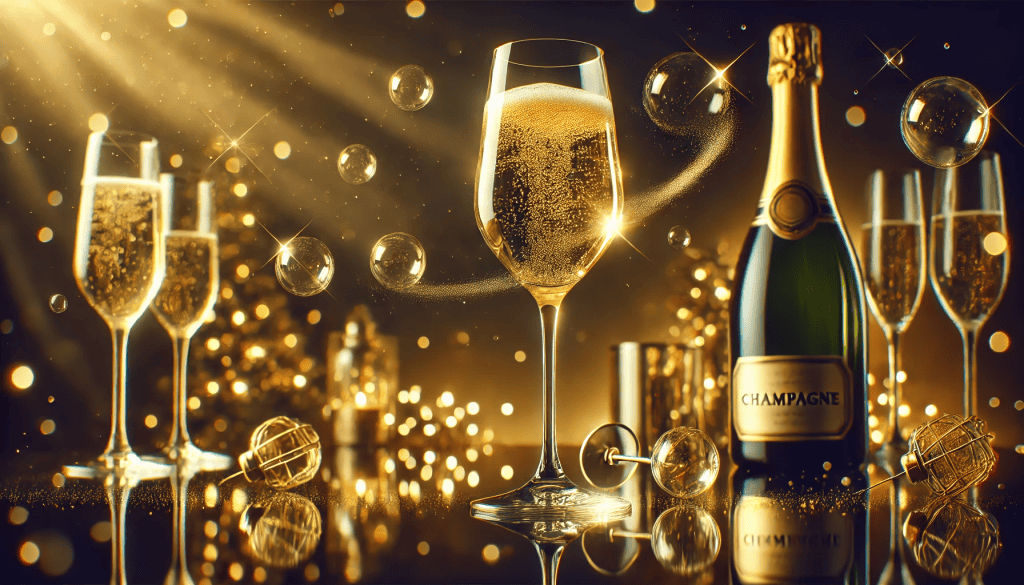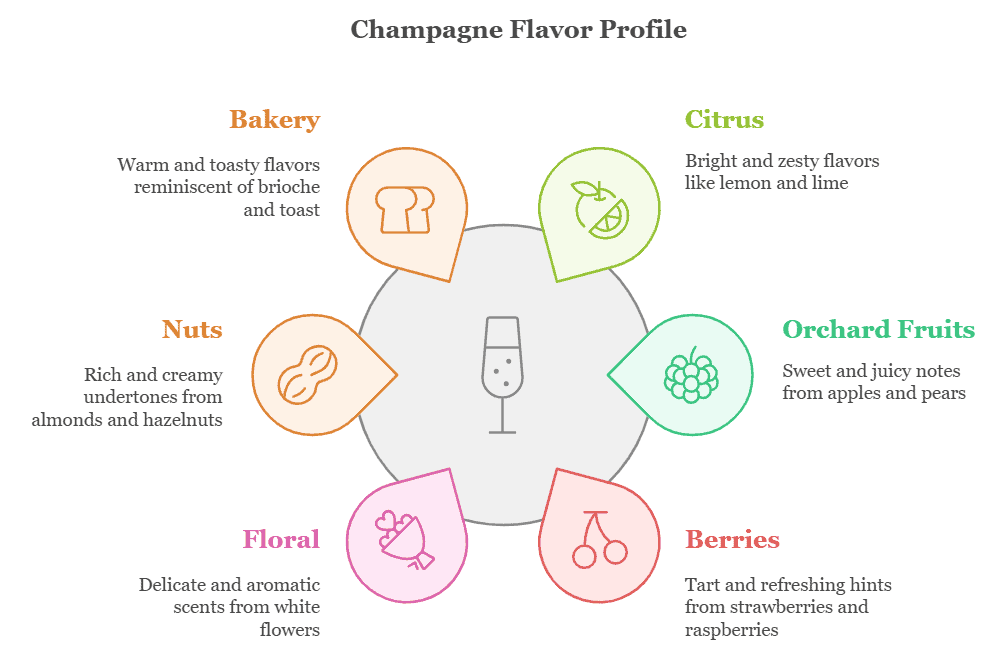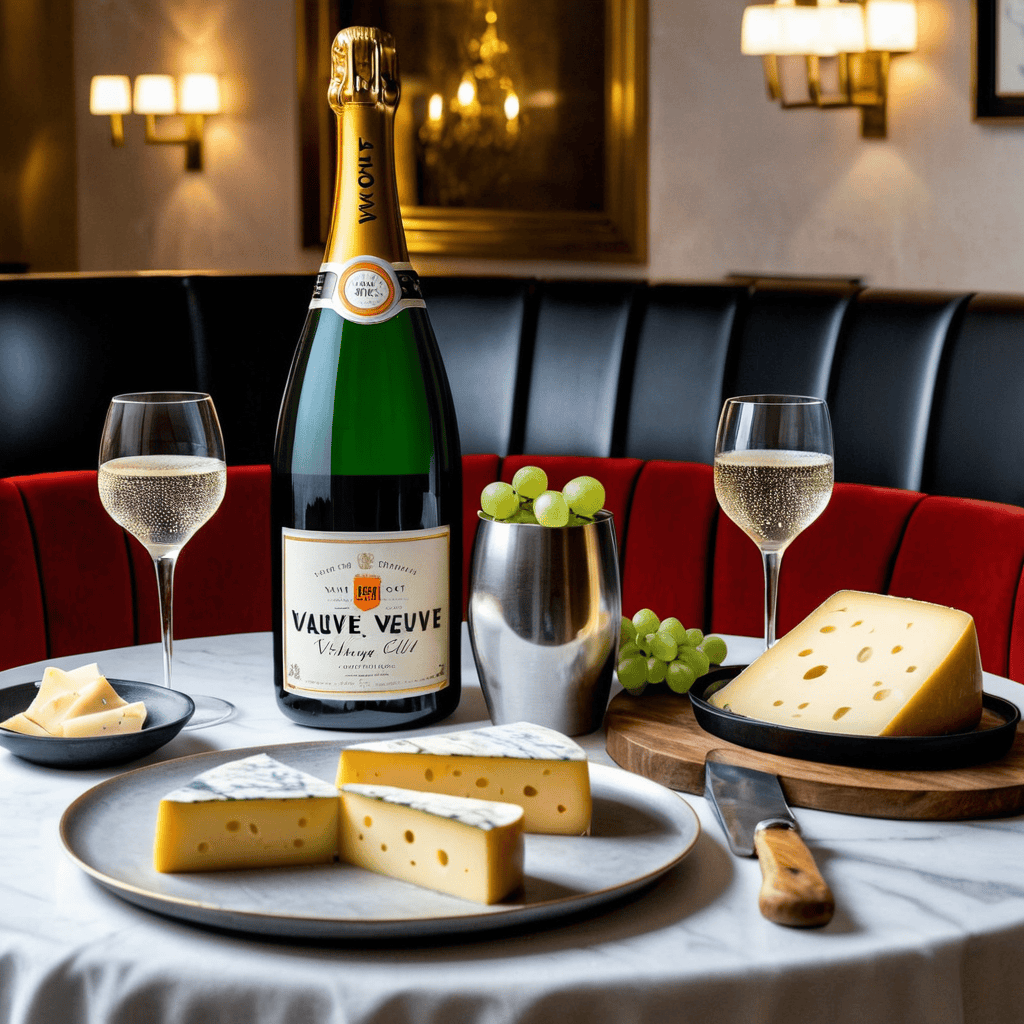Pop, fizz, clink! The sound of a champagne cork popping instantly evokes feelings of celebration and luxury. But have you ever wondered what does champagne taste like, and how you navigate the myriad styles and flavors?
We’ll explore the nuances of taste, unravel the mysteries of production methods, and help you discover your perfect glass of bubbly.
Get ready to elevate your champagne experience and impress at your next soirée!
Welcome to Didi Somm, and Cheers!
Important Notice: The information in this article is for general and public information purposes only. It solely reflects Didi Somm’s or his Staff’s opinion, and no responsibility can be assumed for errors or omissions in the service’s contents. For details, please check the Disclaimer at the bottom of the homepage.

Takeaways
Champagne flavors range from citrusy and floral to rich and toasty
Understanding champagne sweetness levels is key to choosing the right champagne
Production methods and grape varieties significantly influence taste
Terroir plays a crucial role in shaping champagne’s unique characteristics
Proper serving temperature and food pairings enhance the champagne experience
Champagne labels provide essential information for making informed choices
Understanding Champagne:
Before we dive into the intricacies of champagne flavors, let’s uncork some basic knowledge. Champagne is not just any sparkling wine; it’s a protected designation exclusively reserved for sparkling wines produced in the Champagne region of France. This prestigious beverage is crafted primarily from three grape varieties: Chardonnay, Pinot Noir, and Pinot Meunier. The unique combination of these grapes, along with the region’s terroir and traditional production methods, creates the distinct taste that sets champagne apart from other sparkling wines.
Proper storage of champagne bottles is crucial for maintaining their quality and enhancing the tasting experience over time.
Champagne Styles and Blends: Rosé Champagne
Champagne comes in various styles, each offering a unique flavor profile:
Blanc de Blancs: Made exclusively from Chardonnay grapes, this style is known for its delicacy, floral aromas, and crisp acidity. It often exhibits notes of citrus, green apple, and sometimes a hint of minerality.
Blanc de Noirs: Produced entirely from Pinot Noir and/or Pinot Meunier grapes, Blanc de Noirs champagnes tend to be fuller-bodied with richer flavors. Expect notes of red fruits, sometimes with a subtle hint of spice.
Rosé Champagne: Created either by blending red and white wine or by brief contact with grape skins, rosé champagnes offer a diverse palette of flavors. They can range from delicate and fruity to more robust and complex.
Sweet champagne, such as Demi-Sec and Doux, offers a higher sugar content, making it a delightful choice for those who prefer a sweeter taste.

Classification by Sweetness:
The amount of sugar added after the second fermentation, known as the dosage, determines the champagne sweetness level:
Brut Nature (Zero Dosage): 0-3 g/L of residual sugar
Extra Brut: 0-6 g/L
Brut: 0-12 g/L
Extra Dry: 12-17 g/L
Sec: 17-32 g/L
Demi-Sec: 32-50 g/L
Doux: More than 50 g/L
Brut champagnes are the most common and versatile, offering a dry, crisp taste that pairs well with a wide range of foods. The champagnes become progressively sweeter as we move towards Doux, with Doux often reserved for dessert pairings.
Champagne Production Methods:
The production method significantly influences champagne’s taste:
Méthode Champenoise: This traditional method involves a second fermentation in the bottle, creating those signature fine bubbles and complex flavors. It’s the only method allowed for true champagne production. The traditional Méthode Champenoise is essential for creating the complex flavors and fine bubbles that make tasting champagne a unique experience.
Vintage vs. Non-Vintage: Most champagnes are non-vintage, blending wines from different years for consistency. Vintage champagnes from a single year’s harvest offer unique flavors reflecting that specific growing season.
Champagne Regions and Terroir:
The concept of terroir is crucial in understanding champagne’s taste. Different areas within the Champagne region impart distinct characteristics to the grapes:
1. Montagne de Reims:
Known for its belemnite chalk soil, this area produces champagnes with body and power.

2. Côte des Blancs:
The Côte des Blancs is renowned for Chardonnay vines planted in chalky soils, yielding wines with finesse, floral aromas, and marked minerality.
3. Vallée de la Marne:
With diverse terroir including chalk, limestone, and marl soils, the Vallée de la Marne predominantly produces fruitier champagnes from Pinot Meunier grapes.
Champagne Flavor Characteristics: Champagne Flavor Profile
So, what does champagne taste like? When you taste champagne, you experience a complex and multifaceted flavor profile that varies based on factors like grape variety, production method, and aging. However, some typical tasting notes include:
Citrus: Lemon, lime, grapefruit
Orchard fruits: Apple, pear, peach
Berries: Strawberry, raspberry (especially in rosé)
Floral: White flowers, rose
Nuts: Almond, hazelnut
Bakery: Brioche, toast, biscuit
Mineral: Chalk, flint
The texture of champagne is equally important. Expect a velvety mouthfeel with fine, persistent bubbles that create a lively sensation on the palate. The high acidity gives champagne its characteristic crispness and freshness.

Champagne and Food Pairings:
To fully appreciate champagne’s flavors, consider these pairing suggestions:
1. Oysters and seafood:
The mineral notes in Blanc de Blancs complement the French “Moules” perfectly.

2. Fried foods:
The acidity and bubbles in Brut champagne cut through rich, fried dishes.
3. Cheese:
Try a vintage champagne with aged Comté or Parmesan.

4. Desserts:
Pair sweeter Demi-Sec or Doux champagnes with fruit-based desserts.
Remember, serving temperature is crucial.
Non-vintage Brut champagne is best served between 45°F (7°C) and 48°F (9°C) to showcase its full bouquet and finesse.
Champagne Buying Guide:
When selecting a bottle of champagne, pay attention to the label. It provides essential information about:
1. Producer
2. Sweetness level
3. Vintage (if applicable)
4. Grape varieties used
Consider factors like brand prestige, vintage quality, and exclusive releases when investing in champagne. Don’t be afraid to ask for recommendations at your local wine shop.
FAQ – what does champagne taste like
1. Q: What’s the difference between champagne and other sparkling wines?
A: Champagne is produced explicitly in the Champagne region of France using the traditional method. Other sparkling wines may use different production methods and grape varieties.
2. Q: How long does champagne last once opened?
A: With a proper champagne stopper, an opened bottle can last 3-5 days in the refrigerator, though it will gradually lose its bubbles.
3. Q: Can champagne go bad?
A: While champagne doesn’t spoil like food, it can lose its flavor and effervescence over time, especially if stored improperly.
4. Q: What’s the best glass for drinking champagne?
A: A tall, narrow flute helps maintain bubbles and concentrate aromas, though some connoisseurs prefer wider glasses for fuller-bodied champagnes.
5. Q: Is expensive champagne always better?
A: Not necessarily. While prestigious brands often offer high quality, there are many excellent, lesser-known champagnes at more affordable prices.
6. Q: How should I store champagne at home?
A: Store champagne in a cool, dark place, away from vibrations, at a consistent temperature between 45°F to 65°F (7°C to 18°C).
7. Q: What’s the proper way to open a champagne bottle?
A: Hold the bottle at a 45-degree angle, grip the cork firmly, and twist the bottle (not the cork) slowly until the cork eases out with a gentle hiss.
8. Q: Can I use champagne in cooking?
A: Absolutely! Champagne can add a delightful flavor to sauces, risotto, and even desserts.
9. Q: What causes the bubbles in champagne?
A: The bubbles are carbon dioxide, a byproduct of the second fermentation that takes place in the bottle.
10. Q: Is it true that champagne gives worse hangovers?
A: There’s no scientific evidence to support this claim. However, the bubbles may cause alcohol to be absorbed more quickly.
11. Q: What’s the difference between vintage and non-vintage champagne?
A: Vintage champagne is made from grapes harvested in a single, exceptional year, while non-vintage blends wines from multiple years.
12. Q: How many glasses of champagne are in a standard bottle?
A: A standard 750ml bottle of champagne contains about six glasses.
13. Q: Can champagne be aged like still wines?
A: Many high-quality champagnes can benefit from aging, developing more complex flavors.
14. Q: What’s the ideal serving size for champagne?
A: A standard champagne pour is about 4-6 ounces (120-180ml).
15. Q: Is it okay to add ice to champagne?
A: While purists might frown upon it, some producers now make champagnes specifically designed to be served over ice.
Conclusion:
Champagne is more than just a celebratory drink; it’s a complex, nuanced beverage with a rich history and diverse flavor profiles. From the crisp, citrusy notes of a Blanc de Blancs to the rich, toasty flavors of a vintage Brut, there’s a champagne to suit every palate and occasion.
By understanding the various styles, production methods, and flavor characteristics, you can elevate your champagne experience and make more informed choices when selecting your next bottle.
To conclude, the best champagne is the one you enjoy, so don’t be afraid to explore and discover your personal preferences.
Cheers to your champagne journey!
For your reference, the latest articles by Didi Somm include:
- How to Read a Wine Label: 15 Expert Tips
- Built in Wine Refrigerator – 7 Best Solutions for You
- Best Wine Cellar Flooring Ideas For You – 5 Expert Tips
- Long Term Wine Storage – All You Need To Know
- Small Space Wine Storage Solutions – 10 Great Ideas
- How to Store Opened Champagne: Get 5 Expert Tips to Keep It Sparkling
Important Notice: The information in this article is for general and public information purposes only. It solely reflects Didi Somm’s or his Staff’s opinion, and no responsibility can be assumed for errors or omissions in the service’s contents. For details, please check the Disclaimer at the bottom of the homepage.


